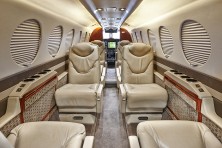Shedding Light on Advancements in Cabin Illumination
By Adam Doyle, Paint & Interior Sales Manager
Lighting is one of the most important elements of cabin design. It serves multiple functions like providing safety, assistance in performing tasks, creating an atmosphere, and in general pulling together the overall design. Understanding cabin lighting technology can assist in making the right decision for your cabin.
At first cabin lighting, choices may seem relatively simple, but with recent advancements, there are a large number of new lighting technologies to choose from. This is a great thing for aircraft owners and operators because lighting can make a big difference in the upgrade of a cabin and cost considerably less than other available upgrades.
The cost of upgrading lighting varies depending on the specific aircraft model and the choice of upgrades. Manufacturers are providing multiple options for almost all different airframes.
LED Technology
The recent influx in lighting advancements is no surprise to the industry because consumer electronics drives what goes into an airplane. As new options are available in the consumer market they are adapted into the aviation market as well.
Recently in the consumer market, there has been a rapid rate of Light Emitting Diode (LED) technology change being driven by the idea that the brighter, the better. This has created new advancements for aviation, too.
Most general aviation aircraft with any kind of up-wash or down-wash lighting come from the factory with Compact Fluorescent Lighting. The problem with CFL is consistency and long-term cost for replacement bulbs and/or power supplies. Don’t forget about the labor involved and the potential for damaging interior components that come with replacement.
LED Lighting
Generally, when deciding to upgrade cabin lighting, the choice is more often than not whether to make the change to LED lighting. LED technology is typically the line between newer and older generation aircraft. Lamp brightness, color, power consumption, heat management, and lamp lifetime are a few of the main differences between the two technologies.
Problems with individual power supplies, hot ballasts, and individual bulb replacements are nearly eliminated with an LED option. Also, when a CFL bulb burns out it is easily noticed, but when individual diodes fail at different times within an LED cluster, they contribute incrementally to illumination decline.
LED technology also offers an overall 50 to 75 percent power savings for an aircraft lighting system. This means problems with individual power supplies, are virtually eliminated with LED.
The technology has safety and aesthetics benefits, too. LEDs are shock resistant, emit low heat, and have no bulb breakage. Also, they emit color consistency and brighter light. Prior to installation, you can even pick different colors as several manufacturers are also beginning to offer optional colored lights.
However, there are different LED options or upgrades.
Plug & Play
A major switch the industry is seeing is from incandescent bulbs for reading lights to LED plug-and-play. The major benefit is cost savings. This option allows you to retain the original fixture. When replacing the fixture don’t forget you’ll incur labor and plating fees along with light longevity.
With plug -and-play lighting, you can pull the face off the light, unplug one bulb and plug the new one in. Plug and play lights are also easy to replace. Once done, that’s the last time you will ever replace it. This means when converting to LED you don’t have to rewire the whole plane and you can do it as needed instead of all at once.
It typically costs anywhere from $300 to $600 to replace just one CFL bulb. On top of that, there is also labor. CFL bulbs have a much shorter life span than LED so it needs to be replaced when the LED typically does not.
Unlike CFL, LED lighting is relatively maintenance-free once installed. The technology has a considerably longer life than fluorescent bulbs. At about 500,000 hours, the useful life of an LED is roughly five times that of incandescent light, according to IDD Aerospace.
This saves labor, materials, and downtime. There is more initial investment for the plug-and-play LED technology but when it comes to the overall life of the aircraft, LED outperforms and will cost less.
Self-ballasted
Self-ballasted lights are another LED upgrade. Un-ballasted lights run off of the aircraft's power supplies while self-ballasted lighting provides its own power. The owner can get rid of extra power supplies because it has its own power.
The need for fewer power supplies creates weight savings, which leads to less fuel usage.
Disadvantages of LED
While offering many advantages, LEDs also present challenges to operators. The rapid rate of LED technology change in the consumer market brings concern to the aviation industry. The idea that brighter is better is driving components to be replaced or updated at a rapid rate. This kind of change rate creates parts obsolescence for the future.
Choosing a source for a particular aircraft interior lighting task ultimately is not as simple as it may seem. Before making a decision it’s best to evaluate all of the options and pick which one is best for the specific aircraft and use.
Adam Doyle joined Elliott Aviation in 2000 as an interior technician after graduating from Wyoming Technical Institute. While at Elliott Aviation Adam has experienced many different promotions on the shop floor including Install Team Lead, Soft Goods Team Lead, Assistant Interior Shop Manager, and Seat Shop Manager. Adam’s most recent promotion has been to Paint and Interior Sales Representative for Elliott Aviation. He uses his experience with various vendors, products, and processes to educate our clients by providing direction and helping plan for future investment with realistic and accurate figures.

